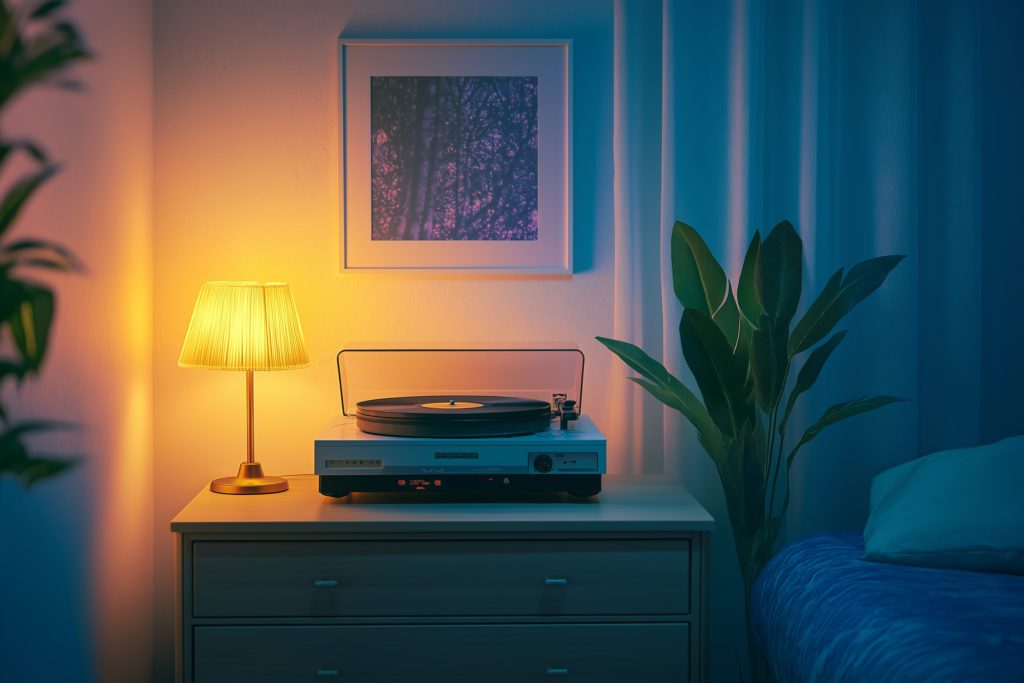
Binaural Beats: How They Work and Why
Binaural beats therapy is a helpful self-help tool that might be able to help you sleep. Here’s more about this helpful tool.

There are many possible causes of a disrupted sleep routine. Stress, jet lag, mental health issues, or sleep disorders can all cause trouble falling or staying asleep. When faced with problems sleeping, many people turn to sleep aids like supplements or prescription medications to treat the problem.
While over-the-counter and prescription sleep aids can be helpful, they can cause side effects, so it’s always a good idea to have other options to help you sleep.
One of our favorites is this relaxation technique that involves using binaural beats.
What Are Binaural Beats?
A binaural beat is an illusion created when you listen to two tones at the same time. Each tone produces a slightly different frequency. When you hear these two tones, your brain will register the tones as a single beat. For example, if Tone A produces a frequency of 400 hertz and Tone B produces a frequency of 410 hertz, your brain will register a beat that is the difference between the two tones. In this example, the perceived tone has a frequency of 10 hertz.
You can use this tone to reach a particular mental state. Different tones may produce different mental states. Depending on the binaural beats you select, you can improve focus or reduce stress. Some binaural beats can induce a state of relaxation or help you fall asleep.
A Closer Look at How Binaural Beats Work
Binaural beats work because of how our brains process sound. When you hear a sound, the parts of your ear work together to move the sound to your brain. Your outer ear funnels the sound waves into your ear canal to your eardrum. When the sound waves reach your eardrum, the eardrum vibrates and moves the sound to your middle and inner ear.
The auditory nerve in your inner ear carries the sound to your brain stem. Your auditory cortex in the temporal lobe takes the sound waves and interprets the sound. When you send a different tone to each ear at the same time, your auditory cortex will take these two tones and create the binaural beat.
The auditory cortex processes information about each sound's frequency, pitch, and tone. As you listen to binaural beats, your brain waves match the frequency of the perceived tone in a process called entrainment.
Brain waves are patterns of electrical activity in the brain. This electrical activity is measured in hertz. When you play a binaural beat, your brain waves will synchronize to the hertz of the sound. Your brain waves' frequency is linked to certain mental states.
There are five ranges of brain waves. The highest-level brain waves, the gamma waves, can indicate heightened focus and perception. If you're trying to solve a difficult problem or learn something new, your brain is producing gamma waves. Beta waves are between 13 and 32 hertz. These brain waves also are good for problem-solving and focus.
As you fall asleep, your brain may produce alpha brain waves, which fall between 8 and 13 hertz. As you progress to REM sleep and active dreaming, your brain is producing waves between 4 and 8 hertz. These waves are known as theta waves. If you are in a deep, dreamless sleep, your brain is producing delta waves. These waves are around 2-3 hertz.
How Binaural Beats Can Help You Sleep
Before selecting a binaural beat, you should consider the cause of your sleep problems. If you are having trouble falling asleep because of anxiety, you may want to try binaural beats in the alpha range. Alpha binaural beats can help you relax as you prepare to fall asleep. If you wake up frequently, the delta binaural beats can help you achieve a deep, restorative sleep.
There is evidence in the scientific community that theta binaural beats can also help reduce your anxiety levels. Some people use theta range binaural beats to improve REM sleep. One study showed that participants who listened to theta range binaural beats reduced their stress levels. These binaural beats slowed their heart rates and lowered their cortisol levels.
If chronic pain is causing your sleep issues, listening to binaural beats may help. One study showed that listening to theta binaural beats for 14 days reduced the listener's pain level. Another study showed that participants with chronic back pain experienced some relief after listening to binaural beats.
A binaural beat between 0.5 and 4 Hz falls in the delta wave range. When your brain waves are in the delta range, you may experience deep relaxation and fall into a deep sleep. A study showed that delta binaural beats reduced anxiety.
Tips for the Best Binaural Beats
If you are interested in using binaural beats to get a good night's sleep, you'll need a pair of headphones. Look for comfortable headphones that produce high-quality stereo sound. Closed-back headphones or in-ear monitors are also good choices for a comfortable, high-quality listening experience. Stay away from earbuds or on-ear headphones. These headphones are often less comfortable or produce lower-quality sound.
The headphones should isolate outside noises to minimize distraction and interference. Many popular brands of headphones pump up the bass, which can distort frequency and affect your listening experience. Instead, you should look for headphones with a neutral frequency.
Each sound must have a frequency that is less than 1000 hertz. To create a state of relaxation or encourage sleep, you should select two tones with a difference in hertz that is less than 30. You can find binaural beats for sleep on streaming video and audio sites.
Binaural beats are just one technique to help you improve your sleep quality. You may need to try different binaural beats over a period of time to achieve the effect you want.

Written by
Emily Mendez
Emily Mendez is a former therapist and mental health author. She is one of the leading voices in mental health. Emily's writing has appeared in eCounseling, SonderMind, and more. Emily is frequently interviewed by Healthline, Fatherly, INSIDER, Family Circle, and other national media for her advice and expert opinion on the latest mental health topics.
Download Pillow
Get help
Press & News
Legal
Connect
X (Twitter)
Company
Copyright © Neybox Digital Ltd.



